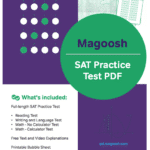Let’s look at the answers to those improving paragraphs questions.
Explanation 1
The problem: There’s a redundancy issue here. “In general” and “for the most part” mean the same thing, so using them both in a sentence—especially right next to each other—is awkward and totally unnecessary. Whenever possible, the SAT prefers shorter, clearer ways of saying things.
(C), (D), and (E) all get rid of “for the most part,” but (C) makes another wordy, redundant structure while (E) changes the tense and meaning of the sentence. (D) is correct.
Explanation 2
The problem: The general pronouns “we” and “you” aren’t interchangeable; you have to choose one and stick with it. Besides that, there’s also a number problem: “first name” and “last names” should be either singular or plural, not one of each.
(C) doesn’t fix either problem, so we can scrap that, but all the others change pronouns and noun numbers. (A) has the wordy, awkward phrase “the one of your family,” which we should avoid. Along with other problems, (D) uses the pronoun “one,” which is way too formal for this passage. Not all SAT writing wants you to use stiff, academic language. Meanwhile, there are two changes in meaning in (E)—notice the “nonetheless,” specifically. (B) is correct.
Explanation 3
The problem: Only children’s books and beginner’s ESL books read like this. Maybe Hemingway could get away with it, but the rest of us want to make it a little less choppy.
Of course, all of the answer choices combine the sentences. Notice how long (A) is. That’s a pretty sure sign that it’s not doing a very efficient job of tying information together. And although it’s nice and short in comparison, (B) just lists the info without relating it. Besides that, there’s the problem in comparing Anny’s last name and “her mother” rather than “her mother’s”. (C) and (D) use “but” and “because” in places where they don’t make sense. Watch out for those linking words and the relationships they convey. (E) is correct.
Explanation 4
The problem: The word “in” is wrong when paired with “the point in time”—it would be “at”—and that whole phrase is redundant when put next to the word “when.” We only need one time word.
Although (C) corrects the first problem, it leaves the second. (B), (D), and (E), meanwhile, all change the meaning illogically. (A) is the only one that gets across the right relationship between time and event.
Want more practice questions?
How about some reading practice? Or would you like to choose which skills to hone a little more specifically?






Leave a Reply